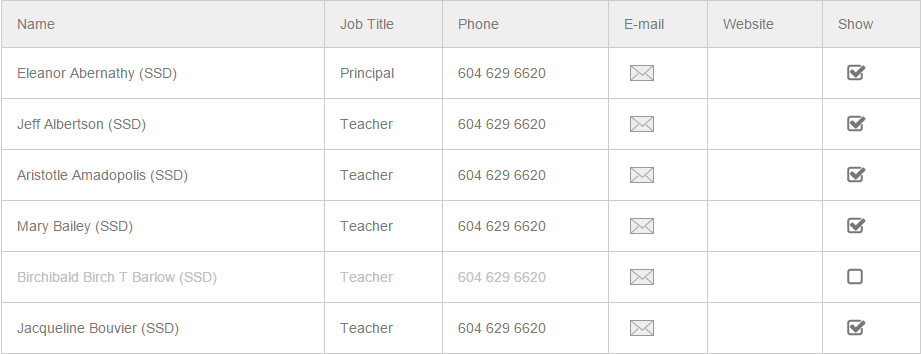User Directory
The user directory app displays a list of people in your district, school or department and their associated contact information. The information displayed comes from your organisation's Active Directory system which is managed by your IT department.
Add the User Directory
Like all apps, you can add or remove the User Directory by editing the page, selecting Add an App, and finding User Directory under the Scholantis category. See Add an App to a Page to learn more about adding apps.
Edit the User Directory
You can easily configure the information displayed, and other general app settings, from the tool pane.
To edit an existing User Directory app Edit the page and select Edit App from the app menu. See Edit or Delete an App from a Page to learn more about editing apps.
The User Directory tool pane displays the settings common to all apps, and those specific to the User Directory.
Control Which Users are Listed
Your system is configured with the various locations (schools and departments) and roles (staff, teachers, administrators) that make up your district.
Select a Location and enter the desired Roles (comma delimited) in the settings tool pane. Select Ok in the settings pane and Save the page to see the updated list of users.
A Show column will appear when you Edit the page. Uncheck the check box to hide the corresponding user from the app. You can also hide users by adding their user names into the User Blacklist in the settings tool pane.
How does it work?
Each location and role maps to a specific Active Directory user group which defines the users which will be displayed. If the correct location and roles are set but there are some users missing you should contact your IT department.
Your IT department can also globally hide specific users by a creating and setting an Active Directory property hideinDirectory set to [true|1|yes]. Learn How to Create a Custom Attribute in Active Directory on Microsoft TechNet.
System Administrators can view the configured Active Directory groups for each location and role. Open System Dashboard, open User Diagnostics and find any user, click the Role Requirements button.
Control Which Columns are Displayed
You can define what information about each user is displayed by entering the Scholantis attribute names and the column's display name into the Columns box of the settings tool pane.
Values should be comma and semi-colon delimited in the following way:
activeDirectory1, AD Column Name 1; activeDirectory2, AD Column Name 2;
Available Columns
Many of the Active Directory attributes referenced below can be viewed or edited in the Active Directory user object dialog. All attributes, including the attribute names and corresponding values, can be found in the Attribute Editor tab.
To access the Attribute Editor tab activate Advanced features (View > Advanced Features) then open a user object dialog.
| Column Name | Description |
|---|---|
| displayName | Uses displayName attribute from Active Directory |
| firstLast | FirstName LastName (in title case, delimited by space). Uses givenName and sn attributes from Active Directory. |
| lastFirst | LastName, FirstName (in title case, delimited by comma). Uses givenName and sn attributes from Active Directory. |
| lastF | LastName, FirstInitial (in title case, delimited by comma). Uses givenName and sn attributes from Active Directory. |
| firstL | FirstName LastInitial (in title case, delimited by space). Uses givenName and sn attributes from Active Directory. |
| title | Typically contains a user's job description. Uses title attribute from Active Directory. |
| description | The description attribute from Active Directory. |
| Email address. Uses mail attribute from Active Directory. | |
| telephoneNumber | Telephone number. Uses telephoneNumber from Active Directory. |
| classes | A link to a teacher's class list page (opens in new window). Displays a link to a page containing the user's name in the Url. The Url is defined by the Classes Url setting. The Classes page is used to display the classes and assignments for a teacher. |
| website | The user's website if available (opens in new window). Displays a link to a user's Scholantis Public Site. |
| comment | The comment attribute from Active Directory. |
| company | The company attribute from Active Directory. |
| contactForm | Links to a contact form that sends an email to the email address specified in Active Directory. The contact form hides user email addreses to prevent spambots collecting staff email addresses. The contact form includes the sender IP address and a CAPTCHA to prevent spam. Uses mail attribute from Active Directory. |
| department | The department attribute from Active Directory. |
| division | The division attribute from Active Directory. |
| employeeID | The employeeID attribute from Active Directory. |
| faxNumber | The facsimileTelephoneNumber attribute from Active Directory. |
| notes | The info attribute from Active Directory. |
| initials | The initials attribute from Active Directory. |
| ipPhoneNumber | The ipPhone attribute from Active Directory. |
| mobileNumber | The mobile attribute from Active Directory. |
| pagerNumber | The pager attribute from Active Directory. |
| webPageUrl | The url attribute from Active Directory. |
| webPageUrl2 | The wWWHomePage attribute from Active Directory. |
All Caps!
The setting allcaps can be added to a column to display a column in capital letters.
Example Columns
displayName, Name, allcaps; title, Job Title; telephoneNumber, Phone;mail, E-mail; website, Website;


